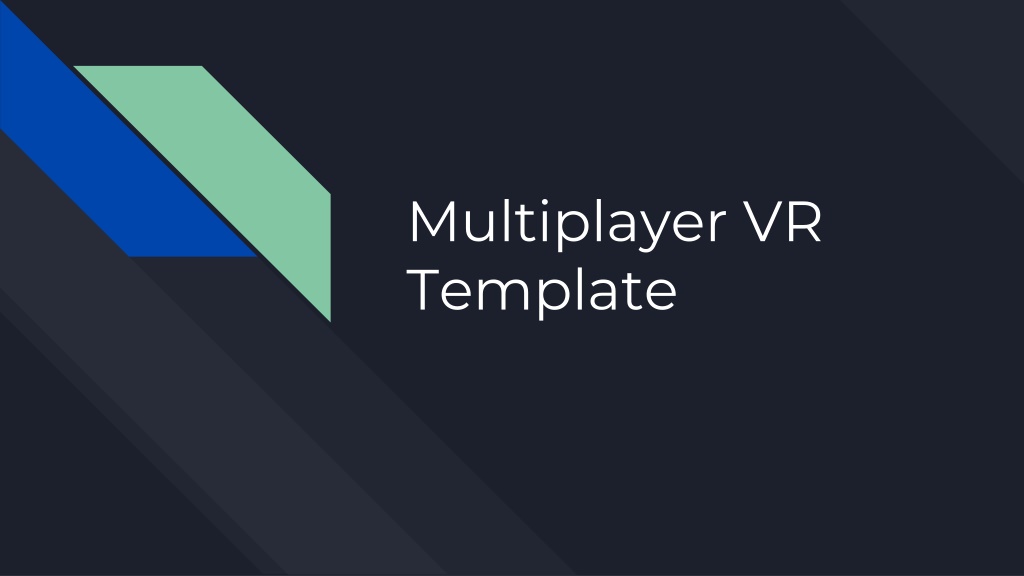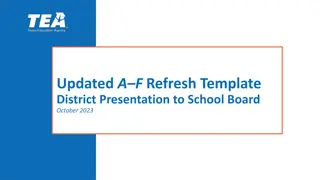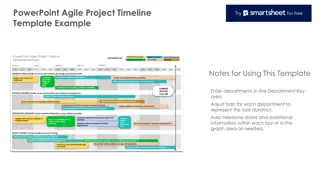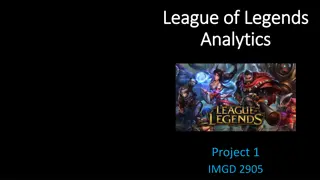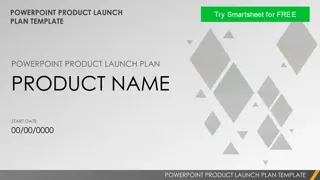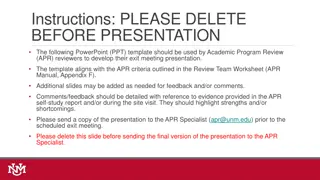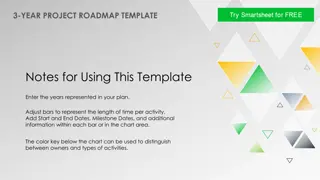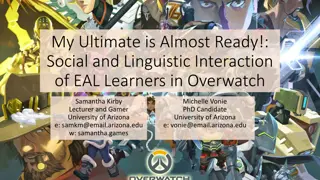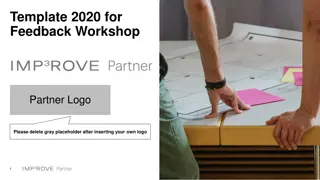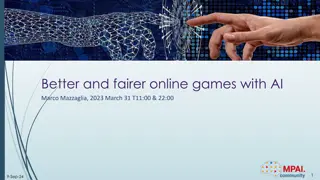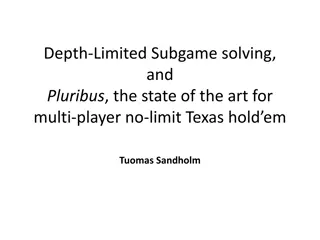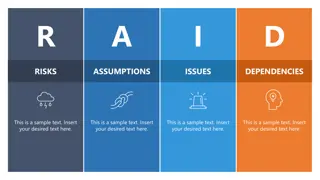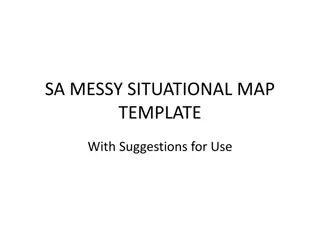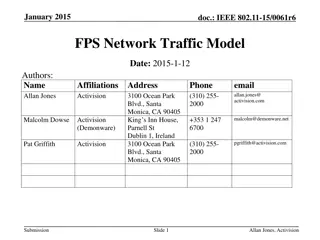Multiplayer VR Template
This template provides a detailed overview of a multiplayer VR environment built using Unity XR Interaction Toolkit, Photon Unity Networking, and Unity OpenXR Plugin. It covers aspects like input actions, interaction handling, and locomotion systems, aiming to assist developers in creating immersive VR experiences. The content also addresses potential issues with peripherals, interaction managers, and XR player functionality.
Download Presentation

Please find below an Image/Link to download the presentation.
The content on the website is provided AS IS for your information and personal use only. It may not be sold, licensed, or shared on other websites without obtaining consent from the author.If you encounter any issues during the download, it is possible that the publisher has removed the file from their server.
You are allowed to download the files provided on this website for personal or commercial use, subject to the condition that they are used lawfully. All files are the property of their respective owners.
The content on the website is provided AS IS for your information and personal use only. It may not be sold, licensed, or shared on other websites without obtaining consent from the author.
E N D
Presentation Transcript
Multiplayer VR Template
Environment Unity 2020.3.21f1 You can probably use a newer version, but this is what the template was built in Unity XR Interaction Toolkit (2.0.0-pre.6) Photon Unity Networking (PUN, v2) Photon Voice (v2) Unity OpenXR Plugin (1.3.1) To maximize platform compatibility Other backends were causing problems
Unity XR Interaction Toolkit Handles some complex tasks for you by implementing Direct interaction (grabbing) Ray interaction (interaction from a distance) Interactable objects Locomotion (Teleportation, sliding, turning) The XR Origin Basic set of functionality for an XR player Provides a camera and HMD tracking to place a user in your virtual world Not very useful on it s own NetworkedPlayer is a modified XR Origin used by the template Prefer to use the action-based XR prefabs
Input Since we are using input actions, the Unity project will be using the new input system i.e. Input.GetKeyDown() won t work The input actions give names to the tracking methods and buttons A few of the important ones Position Rotation Select (the trigger; index finger) Activate (the grip button) Turn (the trackpad)
Input Do peripherals work (e.g. Vive trackers)? maybe? Due to a bug on Valve/HTC s end, trackers used to not work at all This has potentially been fixed since January 11th I ve done some testing, but no success yet The readme on GitHub for this template has some more info about this (in Other Remarks)
Interaction Interactors Interactables Things the user can interact with Interaction Managers Facilitates communication between interactors and interactables You can have multiple, which lets you divide your interactions into distinct categories Teleportation interaction manager UI interaction manager And whatever else you may need Things that interact with the environment Usually your hands
Locomotion The toolkit provides components that do a lot of background work for locomotion Locomotion system Provides access to the XR Origin for locomotion providers Locomotion providers Determine how the user can update their position Teleportation Continuous movement (sliding along the floor smoothly) Snap turning (Turn x degrees instantaneously) Continuous turning (Smooth turing)
Locomotion To use teleportation, we need teleportation areas Place teleportation areas as children of your floor object They should automatically inherit the shape of your floor Ensure that teleportation areas are slightly higher than the floor This lets the teleportation objects see the floor A height difference of +0.001 units should work fine A ray interactor and line visual is a good way to perform the teleportation
Photon A library that introduces networking capabilities in Unity Players enter a room on the Photon server A room is a set of players that may communicate together Synchronizes the state of Unity GameObjects between multiple clients Objects that need to be visible over the network must have a PhotonView component be instantiated at runtime Additional information may need to be synchronized PhotonTransformView: synchronizes position and rotation PhotonRigidbodyView: synchronizes a rigidbody (i.e. velocity) PhotonAnimatorView: synchronizes animation state
Photon To instantiate a prefab over the network with Photon, the prefab needs to be located in the Assets/Resources directory Photon searches this folder for prefab names Instantiation options PhotonNetwork.Instantiate() Object will have the same lifespan as the client PhotonNetwork.InstantiateRoomObject() Object will have the same lifespan as the room Photon will handle the destruction of objects that have exceeded their lifespan
Photon Ownership Transferring ownership A PhotonView can change its owner Remember to set Ownership Transfer to Takeover in the object s PhotonView Why? Whoever owns a PhotonView will see the minimum amount of latency when interacting with the GameObject the view is attached to When should ownership be transferred? Usually when a user picks up an object When else? The owner is the client that is the authority for the object s transform, physics, etc. XRGrabInteractable -> Interactable Events -> Select
Making things happen once Since Photon synchronizes the state of GameObjects, the code you write will be executed on all clients by default Sometimes this will work, but there are other times where we want to make sure Photon only runs code on a single client Instantiating a network object, for example, should only happen once To do this, run the code only if the client is the master client The master client is usually the first client that joins if (PhotonNetwork.IsMasterClient) { }
Making things happen on other clients Remote Procedure Calls (RPCs) A function that gets executed on a client other than yours Can be used to synchronize state that PhotonViews can t handle Can be used to transmit information, such as a chat message
Consequences of runtime instantiation Instantiating things at runtime means that the Unity editor cannot be leveraged to pass references around Instead, we use hook scripts that establish these references at runtime Place it on a prefab with a component that needs a reference to something else Provide the hook with the name of the object that will have that reference Not a very elegant or scalable solution Often used to provide interactables and interactors with references to their interaction manager
Interacting with Menus The NetworkedPlayer prefab also sets the scene up for menus The default NetworkedPlayer has a ray interactor that interacts with menus on the left hand First, create a menu as you normally would in Unity Make sure to place it in world space Then, add the following components to the Canvas object A script to drive your menu interactions An example is the Menu System script in the Template scene Tracked Device Graphic Raycaster Event System XRUI Input Module
The NetworkedPlayer Prefab Instantiated at runtime by Instantiation.cs Manages VR input HMD position/rotation, controller position/rotation, controller buttons Manages locomotion Separates the VR logic from the pieces of the player that are visible over the network Information that needs to be seen over the network is copied (once per frame) from the objects that provide it into an object with appropriate PhotonViews
The NetworkedPlayer Prefab The head The hands Networked representation How other users see you Voice connection Automatically connects to a Photon server for voice communication HMD tracking Camera work Interaction with the environment Hand tracking Locomotion
Why separate the internal and networked parts? The separation of the VR internals and the networked components came about due to a problem between the architecture of SteamVR and Photon in an old version of the template The first user controlled themself and the second user It made sense to make the two pieces distinct This lets you have more control over what information is sent over the network at the cost of writing a little more code Makes it easier to prevent inputs from affecting all users
Networked Representations The local user is unable to see the networked representation, but all other users can The local user instead sees their own hands Animations can also be synchronized to the networked representation Copy/set the respective animation state Use a PhotonAnimatorView to propagate the information over the network For example, the NetworkedPlayer prefab copies the animation state of the local hands to the networked representation of the hands
The NetworkedPlayer Prefab A caveat of the Unity XR Interaction Toolkit: an object can only have one interactor component The Controller Manager combats this Allows the player to cycle through different interaction methods ( controllers ) on one hand By default, you will see a teleportation controller a menu interaction controller a grab controller If you only need one type of interaction, you won t need this
Spawning the Player Spawnpoint prefabs define a place in the world where the player will be placed initially Place them in the world and assign them an index Start from 0 and count upwards The first player will spawn at index 0, the second at index 1, Circular: Will loop back to 0 when you run out of spawn points
Voice Communication NetworkedPlayer also implements a connection to a server that transmits voice The object responsible for this can be found as seen to the right But only at runtime! The error below can be safely ignored It has to do with race conditions related to connecting to our Photon servers
Voice Communication Voice transmission The VoiceConnection prefab has a Transmit Enabled flag (under the Recorder) When this flag is set, voice will transmit across the network You can have it always on or create a script to facilitate push-to-talk
Demonstration A sample game has been made in the Ping Pong scene Demonstrates interactions and ownership transfer This should be one of the first places you look as a reference There is also another scene (called Template) that shows how menus can be used The Multiplayer Base scene contains the minimum components for multiplayer VR A demo of the Ping Pong scene
Useful links GitHub repository for the Multiplayer Template Has installation instructions Documentation for the Unity XR Interaction Toolkit Documentation for Photon Documentation for Photon Voice
Questions Take a look through the template, particularly the NetworkedPlayer and Ping Pong Ball prefabs There s a lot of moving parts that take a while to explain in depth These prefabs should use most of the essential pieces of the template Feel free to email me questions about the template at erik.i.marsh@gmail.com However, I will likely be able to explain things and walk you through issues more clearly in person
